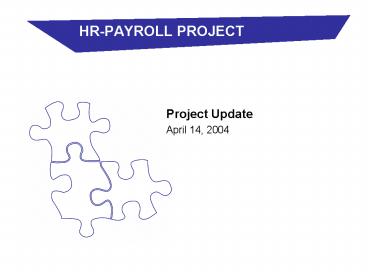HR-PAYROLL PROJECT PowerPoint PPT Presentation
Title: HR-PAYROLL PROJECT
1
HR-PAYROLL PROJECT
- Project Update
- April 14, 2004
2
Goals of the HR-Payroll Project Payroll Phase
- Migrate from paper to web-based transactions
- Leverage SAP and other technologies
- Simplify and standardize business processes
- Single point of data entry
- Faster process flow
- Integrated systems
- Peoples HR records correct, paid correctly and
timely - On time / On budget
3
Status of Business Process Redesign Teams
BPR Team Purpose First Meeting Last Meeting Report Complete
Admin. and SRS Absence Tracking Tracking Admin and SRS vacation and certain medical-related absences 12/12/03 3/01/04
Hourly Timesheet Replacement for e-time 9/24/03 12/17/03 Yes
Salary Dist. Cert. Replacement for DACCA, DINDI, and SANDI 9/11/03 11/18/03 Yes
Employee Health Welfare Benefits Behind the scenes processing of EB benefits and taxable benefits 12/18/03 2/06/04 Yes
Graduate Payroll Graduate student pay / tuition 3/09/04 3/28/04
Managing Payroll Deductions Behind the scenes processing of payroll deductions (i.e., parking) 11/17/03 12/15/03 Yes
Non-Resident Alien Federal taxes for internationals TBD TBD
Academic Other Monthly Pay Faculty Payroll 3/12/04 TBD
Casual Labor Appointment process for vouchers 11/06/03 2/23/04 Yes
4
Payroll Phase Timeline
- Project Preparation
- February May 2004
- Organizational Change Management Team kicked off
Feb. 04 - Blueprinting
- May November 2004
- Realization
- November 2004 June 2005
- Final Preparation
- July 2005 December 2005
- Go Live!
- January 2006
5
Organizational Change Management Team
- Why do we need an Organizational Change
Management Team? - Since the beginning of the HR-Payroll Project,
organizational change issues have been recognized
as critical to the success of the implementation
of SAP. - Because the anticipated impact of the Payroll SAP
module implementation is extensive, reaching all
employees and students, the approach to managing
the changes requires a broad outreach strategy,
employing a broad base of business owners and
stakeholders. - As a result, the Organizational Change Management
Team was formed to further identify and address
issues associated with anticipated changes and
impacts for employees and departments.
6
Organizational Change Management Team Membership
Training Irina Vainstock IS T
Change Management Alyce Johnson HR-Payroll Project
Communication Diana Hughes HR-Payroll Project
Risks Kathleen Flynn Human Resources
Roles and Responsibilities Kathie Lalor Leslie
Wright Payroll
Central Admin Rollout Jean Roberge Sue
St.Croix CAO
Lincoln Lab Pam Weldon Lincoln Lab
DLC Rollout Jennifer Kratchowill HR-Payroll
Project
Students Cynthia Stanton SFS
7
Organizational Change Management Team
- What is the Charge of the Team?
- Translate and deliver future business process
into a new organization design - Conduct change management assessment workshops to
determine appropriate interventions (transition
baseline review) as a mechanism to track/monitor
the effectiveness of the teams strategies - Conduct and manage organizational risk activities
- Review and propose new roles and responsibilities
- Coordinate communication planning effort
- Coordinate training development and training
delivery - Create detailed transition strategy plan to
assure efficient transition to the future
organization design - Work with impacted areas and their employees and
students to help facilitate - a smooth transition
8
Organization Change Management Central
Administration
Bus Process CAO Non Payroll SVC Ctr/Payroll Human Resources IST OSP Budget Data Warehouse
Admin SRS Absence Tracking
Hourly Timesheet
Salary Distribution Certification
Employee Health Welfare Benefits
Graduate Payroll
Managing Payroll Deductions
Non-Resident Alien
Academic Other Monthly Pay
Casual Labor
9
Organization Change Management Central
Administration
Organizational Change Management DRAFT Resource
Group Charter
A. Resource Group Membership
Sponsor HR/Payroll Organization
Change
Team Lead Jean Roberge/Sue St.Croix
- Representatives whose organization
will be affected by the project outcomes has a
vested interest in the project deliverables
and/or impact on the organization
- Represents a department, school or other
constituency of the MIT community (e.g. students)
this team is for central administrative
departments. - B. Justification
- Since the beginning of the HR-Payroll Project,
organizational change issues have been recognized
as critical to the success of the implementation
of SAP. The anticipated impact of the SAP
implementation is extensive, reaching all
employees and students, the approach to
influencing and managing the changes requires a
broad outreach strategy, employing a broader
base of business owners and stakeholders. As a
result, the Organizational Change Management Team
(OCM) was formed to further identify and address
issues associated with anticipated changes and
impacts for employees and departments. - Central Administration departments will be
uniquely impacted by the broad business,
organizational, and procedural changes. It is
key that these changes are reviewed and
understood prior to implementation.
10
Organization Change Management Central
Administration
Organizational Change Management DRAFT Resource
Group Charter (continued)
C. Description
- Act in an advisory capacity provides input and
feedback on the work of the Project. - Meet periodically to review and advise on the
progress of the work - Communicate the status and the progress of the
proposed work, when appropriate, to the
department, school or other constituency that
the Member represents - Solicit feedback from others in their
organization on issues or questions relative to
the work of the Project. - D. Deliverables to be determined may include
- Risk analysis results
- Risk Mitigation Plan
- Communication Plan
- Training Plan
- E. Success Criteria
- Business owners at all levels are engaged and
partner in the policy and process changes
- There is support around early policy and
practice changes - Employees and students have a clear
understanding of what is expected of them and are
able to adapt to the new processes - DLCs have clear direction and understanding
of new processes - Impacted employees are engaged in the change
process

